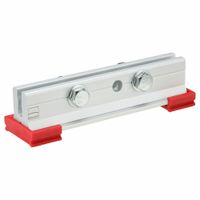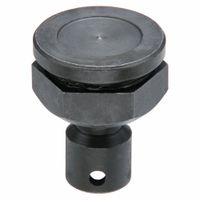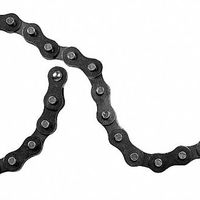Call +(254) 703 030 000 / 751 483 999 / 721 704 777
- Home
- Tools
- Hand Tools
- Clamps
- Clamp Replacement Parts
.....Read More
Frequently Asked Questions
What are the most common types of clamp replacement parts?
The most common types of clamp replacement parts include:
1. **Jaws**: These are the gripping components of a clamp that hold the workpiece securely. They can wear out or become damaged over time, necessitating replacement.
2. **Screws and Bolts**: These are essential for the tightening mechanism of many clamps. They can strip or corrode, requiring replacement to maintain proper function.
3. **Pads**: Often made of rubber or plastic, these are used to protect the workpiece from damage and provide additional grip. They can wear down or become damaged, needing replacement.
4. **Springs**: Found in spring clamps and some other types, these provide the tension needed for the clamp to function. Springs can lose their elasticity or break, requiring replacement.
5. **Handles**: Used for tightening and loosening the clamp, handles can break or become uncomfortable to use over time, necessitating replacement.
6. **Bars or Rails**: In bar clamps or pipe clamps, these components can bend or become damaged, affecting the clamp's ability to hold materials securely.
7. **Pins and Clips**: Used in some clamps to secure moving parts, these small components can be lost or damaged, requiring replacement.
8. **Swivel Pads**: These are used in some clamps to allow for better grip on irregular surfaces. They can wear out or break, needing replacement.
9. **Locking Mechanisms**: In locking clamps, these parts can wear out or break, affecting the clamp's ability to hold securely.
10. **Adjustment Knobs**: Found in some clamps for fine-tuning the grip, these can become stripped or damaged, requiring replacement.
These parts are essential for maintaining the functionality and longevity of clamps, ensuring they continue to perform effectively in various applications.
How do I determine the right size for clamp replacement parts?
1. **Identify the Clamp Type**: Determine the type of clamp you are dealing with, such as hose clamps, pipe clamps, or C-clamps, as each may have different sizing requirements.
2. **Measure the Diameter**: For circular clamps, measure the diameter of the object the clamp will secure. Use a caliper or a measuring tape to get the most accurate measurement.
3. **Consider the Material Thickness**: Account for the thickness of the material being clamped. This is crucial for ensuring the clamp can accommodate the material without being too tight or too loose.
4. **Check the Clamp Range**: Look for the clamp's size range, which is usually indicated on the clamp itself or in the product specifications. Ensure your measured diameter falls within this range.
5. **Assess the Load Requirements**: Determine the load or pressure the clamp needs to withstand. This will help in selecting a clamp with the appropriate strength and durability.
6. **Review Manufacturer Specifications**: Consult the manufacturer's guidelines or specifications for the clamp. They often provide detailed sizing charts and recommendations.
7. **Consider Environmental Factors**: Take into account the environment where the clamp will be used, such as exposure to heat, chemicals, or moisture, which may affect the material choice and size.
8. **Test Fit**: If possible, test fit the clamp on the object to ensure it fits securely and functions as intended.
9. **Consult with Experts**: If unsure, consult with a professional or the supplier for advice on the correct size and type of clamp for your specific application.
10. **Purchase from Reputable Sources**: Buy replacement parts from reputable suppliers to ensure quality and compatibility with your existing equipment.
Where can I purchase clamp replacement parts?
You can purchase clamp replacement parts from the following sources:
1. **Online Retailers**: Websites like Amazon, eBay, and Walmart offer a wide range of clamp replacement parts. You can search for specific parts using the model number or part name.
2. **Manufacturer's Website**: If you know the brand of your clamp, visit the manufacturer's official website. Companies like Bessey, Irwin, and DeWalt often sell replacement parts directly or provide information on where to purchase them.
3. **Specialty Tool Stores**: Stores that specialize in tools and hardware, such as Harbor Freight, Northern Tool, or Rockler, often carry replacement parts for clamps.
4. **Local Hardware Stores**: Chains like Home Depot, Lowe's, or Ace Hardware may have the parts you need in stock or can order them for you.
5. **Industrial Supply Companies**: Companies like Grainger or McMaster-Carr offer a wide selection of industrial tools and parts, including clamp replacements.
6. **Online Marketplaces for Used Parts**: Websites like Craigslist or Facebook Marketplace can be useful for finding used or discounted parts.
7. **Specialized Online Tool Shops**: Websites like Toolbarn or Acme Tools specialize in tools and accessories, including replacement parts.
8. **Local Repair Shops**: Some local tool repair shops may have spare parts or can order them for you.
9. **Forums and Online Communities**: Joining forums or communities related to woodworking or metalworking can provide leads on where to find specific parts.
10. **Direct Contact with Manufacturers**: If you have difficulty finding a part, contacting the manufacturer directly can sometimes yield results, as they may have spare parts not listed online.
Always ensure compatibility with your specific clamp model when purchasing replacement parts.
Are clamp replacement parts universal or specific to brands?
Clamp replacement parts are generally specific to brands rather than universal. While some clamps may have similar designs and functions, manufacturers often produce parts that are tailored to their specific models to ensure optimal performance and compatibility. This specificity can be due to differences in design, materials, and manufacturing standards.
Brand-specific parts ensure that the replacement fits perfectly and functions as intended, maintaining the integrity and safety of the clamp. Using non-specific or universal parts can lead to improper fitting, reduced performance, or even safety hazards, as they may not meet the precise specifications required by the original manufacturer.
However, there are some exceptions where certain generic parts might fit multiple brands, especially if the clamps are designed to industry standards or if the parts are simple and not subject to high stress. In such cases, it is crucial to verify compatibility with the manufacturer or a professional to avoid any issues.
In summary, while there might be some interchangeable parts, it is generally advisable to use brand-specific replacement parts for clamps to ensure proper fit, function, and safety.
How do I install replacement parts on my clamp?
1. **Identify the Parts Needed**: Determine which parts of the clamp need replacement. Common parts include jaws, screws, handles, or pads.
2. **Gather Tools and Materials**: Collect necessary tools such as screwdrivers, wrenches, pliers, and the replacement parts.
3. **Safety Precautions**: Wear safety goggles and gloves to protect against sharp edges or accidental slips.
4. **Disassemble the Clamp**:
- Loosen and remove any screws or bolts holding the damaged part.
- Carefully detach the part from the clamp, noting how it is connected for easier reassembly.
5. **Prepare the Replacement Parts**:
- Inspect the new parts for any defects.
- Clean the area where the new part will be installed to ensure a proper fit.
6. **Install the Replacement Parts**:
- Align the new part with the existing components.
- Secure it in place using the appropriate screws or bolts. Ensure they are tightened properly to avoid loosening during use.
7. **Reassemble the Clamp**:
- Reattach any other components that were removed during disassembly.
- Ensure all parts are aligned and functioning smoothly.
8. **Test the Clamp**:
- Operate the clamp to ensure it works correctly.
- Check for any unusual resistance or misalignment.
9. **Final Adjustments**:
- Make any necessary adjustments to ensure optimal performance.
- Tighten any loose connections.
10. **Maintenance Tips**:
- Regularly inspect the clamp for wear and tear.
- Lubricate moving parts to extend the lifespan of the clamp.
By following these steps, you can effectively replace parts on your clamp and ensure it functions properly.
Can I modify clamps with replacement parts for different applications?
Yes, you can modify clamps with replacement parts for different applications, but there are several factors to consider. First, ensure compatibility between the clamp and the replacement parts. This involves checking the size, material, and design specifications to ensure they fit and function together properly. Using incompatible parts can lead to failure or reduced performance.
Second, consider the application requirements. Different applications may demand specific features such as increased strength, corrosion resistance, or temperature tolerance. Choose replacement parts that meet these specific needs to ensure the clamp performs effectively in its new role.
Third, assess the safety implications. Modifying clamps can alter their load-bearing capacity and structural integrity. It is crucial to verify that the modified clamp can safely handle the intended loads and stresses. Consult manufacturer guidelines or engineering standards to ensure compliance with safety regulations.
Fourth, evaluate the cost-effectiveness of modifications. Sometimes, purchasing a new clamp designed for the specific application may be more economical and reliable than modifying an existing one. Consider the costs of replacement parts, labor, and potential downtime.
Finally, test the modified clamp in a controlled environment before full-scale deployment. This helps identify any issues and ensures the clamp performs as expected in its new application.
In summary, while modifying clamps with replacement parts is possible, it requires careful consideration of compatibility, application requirements, safety, cost, and testing to ensure successful and safe implementation.
What materials are available for clamp replacement parts?
Clamp replacement parts can be made from a variety of materials, each chosen based on the specific requirements of the application, such as strength, durability, corrosion resistance, and cost. Common materials include:
1. **Steel**: Often used for its strength and durability. Stainless steel is particularly popular for its corrosion resistance, making it suitable for harsh environments.
2. **Aluminum**: Lightweight and resistant to corrosion, aluminum is used where weight is a concern. It is not as strong as steel but is easier to work with and can be anodized for additional protection.
3. **Plastic**: Materials like nylon, polypropylene, and PVC are used for their corrosion resistance and electrical insulation properties. They are suitable for lighter-duty applications and environments where metal might corrode.
4. **Brass**: Known for its corrosion resistance and electrical conductivity, brass is used in applications where these properties are essential, such as in plumbing or electrical clamps.
5. **Copper**: Similar to brass, copper is used for its excellent electrical conductivity and corrosion resistance, often in electrical applications.
6. **Titanium**: Used in high-performance applications due to its high strength-to-weight ratio and excellent corrosion resistance, though it is more expensive.
7. **Composite Materials**: These include carbon fiber and fiberglass, which offer high strength and low weight. They are used in specialized applications where these properties are critical.
8. **Rubber and Elastomers**: Used for parts that require flexibility and vibration damping, such as in cushioned clamps.
Each material offers distinct advantages and is selected based on the specific needs of the clamp's application, including environmental conditions, mechanical stress, and cost considerations.



